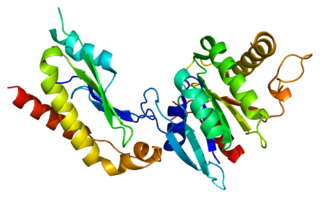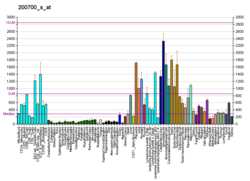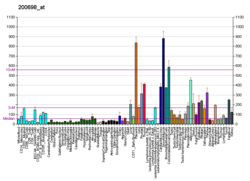
Cartilage associated protein is a protein that in humans is encoded by the CRTAP gene.

Autocrine motility factor receptor, isoform 2 is a protein that in humans is encoded by the AMFR gene.

Ubiquitin-conjugating enzyme E2 G2 is a protein that in humans is encoded by the UBE2G2 gene.

DnaJ homolog subfamily B member 11 is a protein that in humans is encoded by the DNAJB11 gene.

Protein SEC13 homolog is a protein that in humans is encoded by the SEC13 gene.

Translocon-associated protein subunit alpha is a protein that in humans is encoded by the SSR1 gene.

KDEL (Lys-Asp-Glu-Leu) endoplasmic reticulum protein retention receptor 1, also known as KDELR1, is a protein which in humans is encoded by the KDELR1 gene.

Ribosome-binding protein 1, also referred to as p180, is a protein that in humans is encoded by the RRBP1 gene.

Protein transport protein Sec61 subunit alpha isoform 1 is a protein encoded by the SEC61A1 gene in humans.

Ubiquitin-conjugating enzyme E2 G1 is a protein that in humans is encoded by the UBE2G1 gene.

BET1 homolog is a protein that in humans is encoded by the BET1 gene.

Ubiquitin-conjugating enzyme E2 J1 is a protein that in humans is encoded by the UBE2J1 gene.

Signal recognition particle receptor subunit beta is a protein that in humans is encoded by the SRPRB gene.

Protein transport protein Sec24D is a protein that in humans is encoded by the SEC24D gene.

ER lumen protein retaining receptor 3 is a protein that in humans is encoded by the KDELR3 gene.

Reticulocalbin-2 is a protein that in humans is encoded by the RCN2 gene.

Putative pre-mRNA-splicing factor ATP-dependent RNA helicase DHX16 is an enzyme that in humans is encoded by the DHX16 gene.
KDEL is a target peptide sequence in mammals and plants located on the C-terminal end of the amino acid structure of a protein. The KDEL sequence prevents a protein from being secreted from the endoplasmic reticulum (ER) and facilitates its return if it is accidentally exported.
KDEL (Lys-Asp-Glu-Leu) endoplasmic reticulum protein retention receptors (KDELR) are the members of a group of receptor proteins:
HDEL is a target peptide sequence in plants and yeasts located on the C-terminal end of the amino acid structure of a protein. The HDEL sequence prevents a protein from being secreted from the endoplasmic reticulum (ER) and facilitates its return if it is accidentally exported.



















